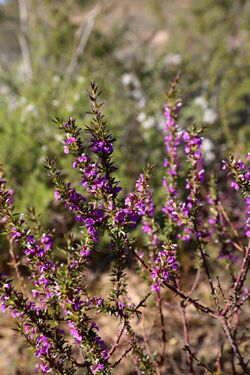Biology:Muraltia heisteria
| Muraltia heisteria | |
|---|---|

| |
LC (SANBI)
| |
| Scientific classification | |
| Kingdom: | Plantae |
| Clade: | Tracheophytes |
| Clade: | Angiosperms |
| Clade: | Eudicots |
| Clade: | Rosids |
| Order: | Fabales |
| Family: | Polygalaceae |
| Genus: | Muraltia |
| Species: | M. heisteria
|
| Binomial name | |
| Muraltia heisteria (L.) DC.
| |
| Synonyms[1] | |
| |
Muraltia heisteria is a shrub in the milkwort family (Polygalaceae) which is native to South Africa and is an emerging invasive species in South Australia.[2] It was first described in 1753 by Carl Linnaeus.
Description
It is a very prickly, erect, sparsely-branched perennial shrub or dwarf shrub which is very rigid and densely branched. It has a height between 20 and 80 centimetres (0.66 and 2.62 ft).[3][4][5][6] It contains hard, thick, spine-tipped, lance-shaped leaves which usually have hairy edges. They are clustered along the stem and are 5 to 10 millimetres (0.20 to 0.39 in) long and 1 to 2 millimetres (0.039 to 0.079 in) wide.[4][5]
It produces small purple, pink, or occasionally white flowers which are thickly studded along the branches and 7 to 12 millimetres (0.28 to 0.47 in) long.[4][5][6][7][8] Its 5 sepals are 4 to 5 millimetres (0.16 to 0.20 in) long and almost equal in length while its 3 petals are 8 to 10 millimetres (0.31 to 0.39 in) long.[7][8]
Taxonomy
It was first described by Carl Linnaeus as part of the Polygala genus in 1753.[9] It was reclassified as a Muraltia in the 1760s.[10] It is named after Lorenz Heister, a German surgeon and botanist.[4]
Habitat and ecology
It is native to lower rocky mountain slopes with altitudes between 5 and 1,705 metres (16 and 5,594 ft) in Eastern Cape, Northern Cape, and Western Cape and has been introduced to South Australia, New South Wales, and Victoria.[3][4][5] The plant has been shown to naturally self-pollinate.[10] It flowers between October and December in native areas, and between June and November in Australia.[4][5][8] It serves as the host plant of the insect Pseudococcus muraltiae.[11] According to the Red List of South African Plants, it is of least ecological concern and its population is stable.[12]
Uses
The flowering twigs of the plant are used as an appetite stimulant in the local area and the plant is cultivated in Australia.[10]
References
- ↑ "Muraltia heisteria (L.) DC.". Royal Botanic Gardens Kew. https://powo.science.kew.org/taxon/urn:lsid:ipni.org:names:690821-1. Retrieved July 9, 2020.
- ↑ "Muraltia Fact Sheet". https://cdn.environment.sa.gov.au/landscape/docs/hf/Muraltia-fact-sheet.pdf.
- ↑ 3.0 3.1 "Muraltia heisteria (L.) DC". Conservatoire et Jardin botaniques Ville de Geneve. http://www.ville-ge.ch/musinfo/bd/cjb/africa/details.php?langue=an&id=115373. Retrieved July 9, 2020.
- ↑ 4.0 4.1 4.2 4.3 4.4 4.5 "Muraltia heisteria". Hermanus Botanical Society. https://www.fernkloof.org.za/index.php/all-plants/plant-families/item/muraltia-heisteria. Retrieved July 9, 2020.
- ↑ 5.0 5.1 5.2 5.3 5.4 "Muraltia heisteria". Government of Victoria, Australia. https://vicflora.rbg.vic.gov.au/flora/taxon/d45b11cb-4184-4223-9492-bb2ba7022d8d. Retrieved July 9, 2020.
- ↑ 6.0 6.1 "MURALTIA Heisteria DC. [family POLYGALACEAE"]. JSTOR. https://plants.jstor.org/stable/10.5555/al.ap.flora.floc000476. Retrieved July 9, 2020.
- ↑ 7.0 7.1 "Muraltia heisteria (L.) DC.". Government of New South Wales. http://plantnet.rbgsyd.nsw.gov.au/cgi-bin/NSWfl.pl?page=nswfl&lvl=sp&name=Muraltia~heisteria. Retrieved July 9, 2020.
- ↑ 8.0 8.1 8.2 "Fact sheet for Muraltia heisteria". Government of South Australia. http://www.flora.sa.gov.au/cgi-bin/speciesfacts_display.cgi?form=speciesfacts&name=Muraltia_heisteria. Retrieved July 9, 2020.
- ↑ "Polygala heisteria L., Sp. Pl. 2: 704 (1753)". https://www.ipni.org/n/691561-1. Retrieved July 9, 2020.
- ↑ 10.0 10.1 10.2 "Muraltia heisteria". http://pza.sanbi.org/muraltia-heisteria. Retrieved July 10, 2020.
- ↑ "Pseudococcus muraltiæ n. sp.". Annals of the Entomological Society of America (Entomological Society of America) 5: 184–186. 1912. https://www.biodiversitylibrary.org/page/11920698#page/202/mode/1up.
- ↑ "Muraltia heristeria (L.) DC.". http://redlist.sanbi.org/species.php?species=3612-71. Retrieved July 9, 2020.
Wikidata ☰ Q15578563 entry
 |

